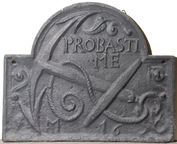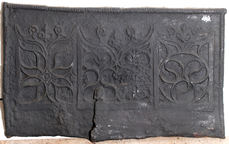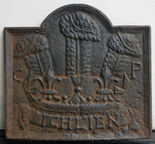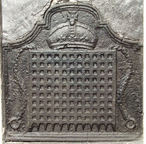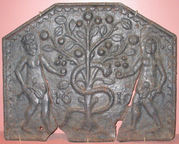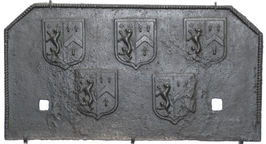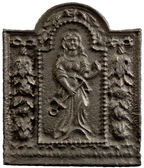-
1126
Description: Canted rectangular shape; twisted rope edging (top and sides); cavetto-moulded-edged rectangle top centre, enclosing date between initials CT; five shields of Ayloffe impaling Sulyard in two rows (3-2); Ayloffe: sable, a lion rampant Or, collared gules, between three crosses formy of the second; Sulyard: argent, a chevron gules between three pheons inverted sable.
Notes: William Ayloffe (c1535-1584) of Bretons, Hornchurch, Essex, Justice of the Court of Queen’s Bench, married (c1560) Jane, dau. of Sir Eustace Sulyard, of Runwell, Essex. The initials 'CT' are likely to be those of Charles Tyler, a founder whose working life and that of his family have strong parallels with the occurrence of these firebacks. The smallest dated example in this series.
Inscription: C.1.6.0.9.T
Arms: Ayloffe impaling Sulyard (William Ayloffe of Bretons, Hornchurch)
- Decoration tags:
- rectangular with canted top corners (shape)
- rope (edging)
- carved stamps
- individual letters
- individual numbers
- heraldic
- armorial
- text
Manufactured: in 1609 possibly at Bedgebury Furnace, Goudhurst in the Weald area of England.
Current location: The Crown Inn, The Green, Horsted Keynes, West Sussex, England.
- Attached to series:
- Ayloffe series
- Personal armorial firebacks
-
408
Description: Arched rectangular shape; cavetto moulded edge all round; holes pierced in top corners; a fouled anchor with one fluke resting on the base, a scroll below each top corner, foliage above the text, which is above the anchor; the initials either side of the lower fluke.
Notes: The inscription is a quotation from Psalms 139, v. 1: ‘Domine, probasti me et cognovisti me’ (Lord, thou hast searched me and known me).
Copies of this fireback are known.
Inscription: PROBASTI / ME / I M 16 5[0?]
- Decoration tags:
- rectangular with round arch (shape)
- cavetto (edging)
- whole carved pattern
- individual numbers
- planklines
- pictorial
- biblical
- text
- objects
Manufactured: in the mid-17th century possibly at Brede Furnace in the Weald area of England.
Current location: Anne of Cleves House, Southover High Street, Lewes, East Sussex, England.
Museum number: LH000.908 (part of the Sussex Archaeological Society museum group)
Citation: Dawson, C., 1903, 'Sussex Iron Work and Pottery', Sussex Archaeological Collections, 46, pp. 1-54.
-
444
Description: Rectangular; top and side edging formed from the repeated stamping of a short length of twisted rope; three gothic panels arranged horizontally, the centre one wider than the other two, each panel a symmetrical arrangement of tracery patterns with an inverted ogee arch on top incorporating two flowers; a separate fleur-de-lys stamp has been repeated above each panel.
Notes: The panels were probably derived from a dismantled wooden chest or hutch table, c.1500. Their gothic style belies the probable age of the fireback, such chests already being old when their parts might have been re-used. H.R. Schubert (1957, p.259) speculated that this fireback might have been imported from Cleves, where a furnace near Stolberg produced similar castings. That the same panels are on a fireback at Nymans, Handcross (no. 99), makes English manufacture more probable.
- Decoration tags:
- rectangular (shape)
- rope (edging)
- carved pattern panels
- architectural
- objects
Manufactured: in the early- to mid-16th century in the Weald area of England.
Current location: East Grinstead Museum, East Grinstead, West Sussex, England.
Museum number: LH000.796 (part of the Sussex Archaeological Society museum group)
Citation: Butterfield, W. R., 1916, 'Old Wealden Firebacks', The Connoisseur, 46, pp. 197-209.
Citation: Dawson, C., 1903, 'Sussex Iron Work and Pottery', Sussex Archaeological Collections, 46, pp. 1-54.
- Attached to series:
- Gothic panel series
- Furniture stamp firebacks
-
198
Description: Arched rectangular shape; cavetto-moulded edging; English royal coronet with three ostrich feathers rising from within; below, a motto scroll with inscription.
Notes: The badge of the Prince of Wales; the initials, CP, are probably for Carolus Princep; the motto is mis-spelled in error for 'Ich Dien' - I serve, which is more likely a mistranscription rather than a deliberate slur. The apparent crack in the angle of the arch and the top left of the fireback is an impression, indicating that this is a recasting.
Copies of this fireback are known.
Inscription: C P/ICH LIEN
- Decoration tags:
- rectangular with round arch (shape)
- cavetto (edging)
- whole carved pattern
- heraldic
- royal
- text
Manufactured: in the mid-17th century possibly in the Weald area of England.
Current location: not known.
- Attached to series:
- Prince of Wales firebacks
-
592
Description: Flattened arched rectangular shape with rebated concave shoulders; double fillet edging; 11 x 9 grid portcullis with symmetrical chains in ‘S’ arrangement ending in a ring, from top corners, surmounted by an arched royal crown.
Notes: Whole pattern; the portcullis has a realistic, rather than symbolic, appearance.
Copies of this fireback are known.
- Decoration tags:
- rectangular with canted top corners and round arch (shape)
- stepped fillet (edging)
- whole carved pattern
- heraldic
- pictorial
- objects
Manufactured: in the late-16th to early-17th century in England.
Current location: Ham House, Richmond, Surrey, England.
Museum number: 1140112 (part of the National Trust museum group)
- Attached to series:
- Miscellaneous royal firebacks
-
601
Description: Rectangular; astragal and fillet moulding on top and side edges; symmetrical layout of date and initials; date split between left and right sides, initials in middle, central letter in line with date, outer letters lower.
Notes: One of a series of backs dating to the 1730s and 40s using very similar sets of letters and numerals. K may relate to the surname, while the F and S may relate to the initials of husband and wife respectively. Sold at Christie's Masters and Maker auction, 30 November 2010, lot 521 (£1000 part with no. 623, no. 634 and no. 637). Mander Auctioneers, Sudbury, Suffolk, 2 Dec 2023, lot 455 (ns); 20 Jan 2024, lot 289 (£30 part).
Inscription: 17 K 38 / F S
- Decoration tags:
- rectangular (shape)
- astragal & fillet (edging)
- individual letters
- individual numbers
- planklines
- text
Manufactured: in 1738 in the Weald area of England.
Current location: not known.
- Attached to series:
- 1730s-40s, date & initial series
-
697
Description: Canted rectangle; embattled, cavetto moulded edging; central tree with fruit and leaves, a snake, facing right, with a human face in profile entwined, in ‘S’ shape, around the trunk and lower branches; to the left, a naked, bearded male figure holding an apple in his left hand and a branch in his right for modesty; to the right a naked female figure with apple and branch also; the date split either side of the snake and tree trunk.
Notes: Similarities with an armorial in the date, numerals and edging suggest a common pattern-maker.
Copies of this fireback are known.
Inscription: 16 19
- Decoration tags:
- rectangular with canted top corners (shape)
- embattled cavetto (edging)
- whole carved pattern
- pictorial
- biblical
- text
- animals
- humans
- plants
Manufactured: in 1619 in England.
Current location: Stroud District Museum, Stroud, Gloucestershire, England.
Museum number: STGC 2371 (part of the Stroud Museum museum group)
- Attached to series:
- 1619 series
- Old Testament & Apocrypha firebacks
- Adam & Eve firebacks
-
741
Description: Rectangular, with canted top corners; twisted rope edging (top and sides only); five shields of Ayloffe impaling Sulyard in two rows, 3-2; Ayloffe: sable, a lion rampant Or, collared gules, between three crosses formy of the second; Sulyard: argent, a chevron gules between three pheons inverted sable. Two cut notches probably for firedogs.
Notes: William Ayloffe (c1535-1584) of Bretons, Hornchurch, Essex, Justice of the Court of Queen’s Bench, married (c1560) Jane, dau. of Sir Eustace Sulyard, of Runwell, Essex. A large number of variants use the same shields. The excrescences affecting the left and right sides respectively of the lower shields are the result of inexpert ladling of the iron during casting. Part of the bequest to the Victoria and Albert Museum by Lieut. Colonel G. B. Croft-Lyons in 1926.
Arms: Ayloffe impaling Sulyard (William Ayloffe of Bretons, Hornchurch)
- Decoration tags:
- rectangular with canted top corners (shape)
- rope (edging)
- carved stamps
- armorial
Manufactured: in the early-17th century in the Weald area of England.
Current location: Victoria & Albert Museum, Cromwell Road, Kensington & Chelsea, Greater London, England.
Museum number: M.621-1926 (part of the Victoria & Albert Museum museum group)
- Attached to series:
- Ayloffe series
- Personal armorial firebacks
- Andiron slot firebacks
-
1009
Description: Narrow, arched rectangular central panel with bead edging; a standing female figure in flowing robes, facing forward, holding in her right hand a slanting inverted anchor, a poorly modelled left arm apparently beckoning; arched rectangular border with cavetto-moulded edging enclosing, on each side of the central panel, a festoon of acanthus suspended from a ribbon bow; along the base is a line of acanthus leaves; under the arch, descending foliage.
Notes: The figure is likely to be an allegory of Hope. A recasting, hence the loss of image definition.
Copies of this fireback are known.
- Decoration tags:
- rectangular with round arch (shape)
- cavetto (edging)
- whole carved pattern
- pictorial
- allegorical
- humans
- plants
- objects
Manufactured: in the late-17th century in England.
Current location: Westland Ltd, St Leonard's Church, Leonard Street, Shoreditch, London, England.
- Attached to series:
- Carolean 'Dutch' series

